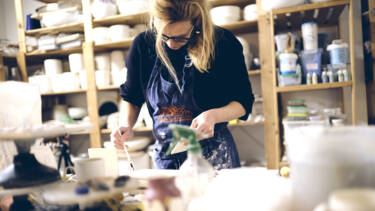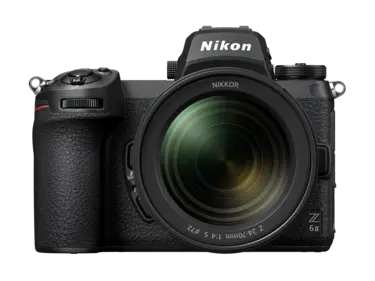The next-level magic of f/1.4

Master the wide f/1.4 aperture of a fast prime lens and the creative rewards will follow
If you are looking to upgrade from a kit lens like a 24-70mm zoom (very useful though it is) to something a little more ‘pro’, investing in a fast prime lens like the NIKKOR Z 35mm f/1.4 or NIKKOR Z 50mm f/1.4 can be a game-changer for your photography and videography.
But why is aperture a key feature to consider? A lot of photo and video makers ‘get’ the focal length attributes for lenses relating to field of view. But while they know the difference between wide angles and telephotos, they often don’t seem to realise the creative opportunities offered by that super-fast aperture. There’s certainly a lot more to a f/1.4 than making things brighter!
Thanks to the Nikon Z mount, the big increase in the mount’s radius compared to the previous F mount means that the f/1.4 aperture is simpler to achieve. This is bringing the price down for lenses with an aperture that used to be the province of only the most premium glass.
This super-wide f-stop makes for amazing background separation, great low-light performance and creative depth-of-field effects – and can elevate your visuals from the ordinary to the truly cinematic.

Jacqueline at her studio, JHA Porcelain in Florence. With such a fine depth of field you can really maximise the power of sharp focus in your subject as you see here, and by also blurring out the background and foreground (as in the opening image).
What’s so great about 1.4?
A fast aperture of f/1.4 means your lens allows in significantly more light than standard zoom lenses, which often start at f/3.5 or f/4. This wide aperture opens up creative possibilities by allowing for:
- Shallow depth of field (DOF): creating beautiful subject isolation with that dreamy bokeh.
- Superior low-light performance: enabling cleaner, noise-free images in dim environments.
- Faster shutter speeds: freezing action without needing to increase ISO.
So far, so great, but what can you actually use it for?
Beautiful dreamer
One of the biggest selling points of that f/1.4 stop is its ability to create an ultra-shallow depth of field. For portraits, this means the subject is the clear focus of your frame, with the background just blurring into a very pleasing soft focus. It’s not just people, either, as shallow product shots also ensure the thing you’re selling is front and centre.
It’s a look prized by movie makers, too. There’s something very ‘cinema’ about having a sharp subject against a blurred background. This is the trick Apple pulls digitally with its ‘cinematic’ movie mode on the iPhone.
Tip: When photographing portraits, keep a comfortable distance from your subject and ensure the eyes are in sharp focus. The depth of field at f/1.4 can be razor-thin, so make sure to engage Subject Tracking AF.
How low can you go?
An f/1.4 aperture is a must-have for low-light photography and videography. It’s a massive help if you often work in interiors, your project calls for night scenes or you find yourself in dimly lit venues. Having to cart around lights or flash units can remove the spontaneity from your captures, plus they tend to blast the scene with a light source that doesn’t ‘belong’, giving a totally different feel.
Tip: Even in times of teeny pictures on social media, I still hate noise in my stills or footage. When photographing at f/1.4 in low light, use your camera’s ISO performance wisely – I always start with a lower ISO and increase it only if necessary. This avoids excessive grain, making your capture much more flexible later.
Shallow focus, deeper story
For videographers, f/1.4 opens up new narrative possibilities by directing the viewer’s focus and creating depth in scenes. The separation of the subject from the background works great for interviews or dialogue scenes, keeping the background present, but less of a distraction to the action.
You can even go nuts creatively. That creamy bokeh and blur can create a very impressionistic frame. It can look so striking at night in street scenes where all those colourful lights from shops and streetlights can blur into abstract shapes – especially effective if you add in some slow motion.
Tip: Keep your subject at a comfortable distance to maintain some control over the depth of field.
Action stations
With all that light flooding in, you can really look to use faster shutter speeds, making it an excellent choice for action photography in both daylight and low-light conditions. Remember that shallow focus can help you double the power of that ‘freezing’ of the action by popping your subject out of a blurry background. Pretty much every great sports photo is a single moment, sharp against a blurry background, but you don’t have to have an eye-wateringly expensive 600mm lens that takes two people to carry to pull it off!
Dial in a subject for your autofocus – faces, animals, cars, etc – and chase the action. Whether it’s kids in the garden or the dog running around a field, put a decent-sized storage card in your camera and click away. You’ll shoot a ton to start with but, with practice, great autofocus and a fast shutter speed, you’ll begin to anticipate a moment.
Tip: When using f/1.4 for action shots, try burst mode to increase your chances of getting a perfect frame.

A flower market in Florence. Use that beautiful blur to create frames within frames.
Creative compositions
This is my number one reason for challenging myself with f/1.4, and the two recent 35mm and 50mm releases from NIKKOR were a great set of primes to lean into. A wide aperture isn’t just for portraits and low light – it also adds depth and artistry to compositions. It makes you look to create layers of importance in a frame, asking questions such as, “What do I need in focus so my audience ‘gets’ the subject quickly?”, “What’s a distraction in this frame I want to blur out?” or “How can I use out-of-focus elements to create layers of action or frame my subject?”
Tip: If your background is distracting, step closer and use f/1.4 to melt it away into a soft blur that still hints as to what it is. For example, you can see a gallery owner in sharp focus, but you can see there are pictures hanging in the background, even if they are out of focus. One glance will tell the viewer a lot about her and what she does.

A busker in Florence. Trust your autofocus and keep your shutter speeds high to freeze the action.
Digging deeper
An aperture of f/1.4 is a fantastic tool, but it’s not always the best choice for every situation and it can be tricky to handle when you are up against it. Sometimes stopping down even slightly (to f/2 or f/2.8) can change sharpness and depth of field drastically. Just a couple of stops can give you a lot more wriggle room in your focus – very handy when you are under pressure.
Situations where I look for a little more focus range include group portraits, where you have a lot of faces you need to keep sharp, and landscapes, where a very narrow focus depth can make for an interesting change to the more common super-sharp sweeping view, but too narrow makes too much of your frame indistinct and redundant.
Also keep your eye (literally) on portraits and mix it up. A single eye in focus is very striking, but are you missing the personality other elements of the subject can bring?
Tip: Use Aperture Priority mode to quickly adjust between f/1.4 and smaller apertures depending on the scene.
Which one? 35mm or 50mm for your f/1.4?
It’s a very personal choice, and there’s no right one to kick off with but, if you’re considering your first f/1.4 lens, here’s how I’d compare the two:
- Go for the NIKKOR Z 35mm f/1.4 if you want a more versatile field of view that works for both portraits and wide shots.
- Opt for the NIKKOR Z 50mm f/1.4 if you love closer portraits and extreme background separation.
Tip: These two primes are a great double act for video. Using them both in one video gives you creative flexibility in composition but with the same ‘feel’ when cutting between the two.

Linfa Studio Gallery in Florence. A 35mm coupled with incredibly shallow focus can add a cinematic edge to close-up details, adding real impact to your B-roll.
Go large
A fast f/1.4 lens is one of the best investments you can make in your photography and videography journey. Whether you want to create amazing cinematic videos, beautiful naturalistic portraits or be confident in even the darkest interiors, creating mood and mystery, mastering this uber-wide aperture opens up a world of creative possibilities.
If you go back and look at the content on your phones and laptops, the very wide angle, very stopped-down apertures of smartphones have created a digital world around us that’s super-sharp and very spiky. But as analogue creatures, that’s not how we see it.
When you’re crazy in love, isn’t everything else just a blur compared to your partner, who’s the soul focus of your world? That’s real life f/1.4!
So relax, open up and let your creativity breathe.
Discover the NIKKOR Z 50mm f/1.4
Featured products

Unlock greater creativity









